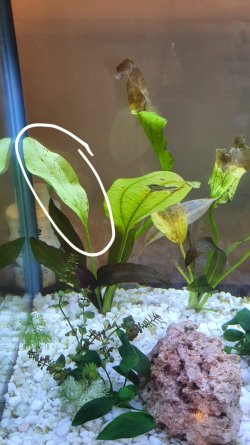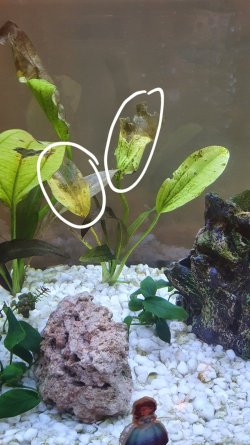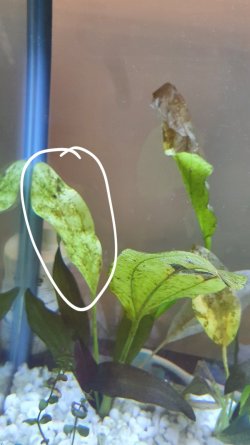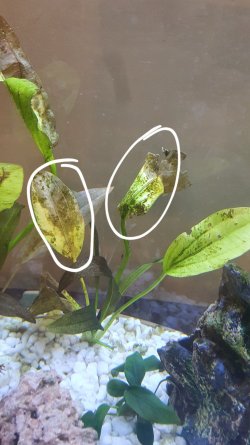Just to make surer you are correctly identifying the issues. Cyanobacteria occurs in slimy sheets that will cover anything and it can easily be loosened with your fingertips. Problem algae like black brush cannot easily be loosened, on fine plants it will usually not ever come off.
-
Guest, the Tank of the Year contest is underway!
💧 Which tank will win? 👉 View the entries and vote now!!
You are using an out of date browser. It may not display this or other websites correctly.
You should upgrade or use an alternative browser.
You should upgrade or use an alternative browser.
Plants not growing well
- Thread starter Vikasr
- Start date
I could easily remove them from the ornaments and anubias leaves. But the suction did not seem to remove it from the substrate. Maybe rubbing would be required to remove the Cyanobacteria?Just to make surer you are correctly identifying the issues. Cyanobacteria occurs in slimy sheets that will cover anything and it can easily be loosened with your fingertips. Problem algae like black brush cannot easily be loosened, on fine plants it will usually not ever come off.
The water changes are going on.
However, today I tried rubbing a leaf of the sword plant with my fingers as it looked dirty so just wanted to confirm whether its the leaf itself or some coating. The blackish color came off while I rubbed the leaf between my fingers and the leaf turned green and clean.
Does it mean that sword plant also has BGA on its leaves? Should I remove it from the tank and clean with tap water (like I did for anubias) or just clean the leaves with my fingers while planted in the tank? Its been just over a month since it was planted.
However, today I tried rubbing a leaf of the sword plant with my fingers as it looked dirty so just wanted to confirm whether its the leaf itself or some coating. The blackish color came off while I rubbed the leaf between my fingers and the leaf turned green and clean.
Does it mean that sword plant also has BGA on its leaves? Should I remove it from the tank and clean with tap water (like I did for anubias) or just clean the leaves with my fingers while planted in the tank? Its been just over a month since it was planted.
Can anybody give me suggestion whether this is good or I should change to Flourish Comprehensive?Contents of my liquid fert in ppm is:
N: 0
P: 0
K: 3.6
Mg: 0.5
Fe: 0.11
Mn: 0.03
Zn: 0.02
B: 0.02
Cu: 0.005
Mo: 0.0005
The details say its derived from chelated salts and vital acids.
The water changes are going on.
However, today I tried rubbing a leaf of the sword plant with my fingers as it looked dirty so just wanted to confirm whether its the leaf itself or some coating. The blackish color came off while I rubbed the leaf between my fingers and the leaf turned green and clean.
Does it mean that sword plant also has BGA on its leaves? Should I remove it from the tank and clean with tap water (like I did for anubias) or just clean the leaves with my fingers while planted in the tank? Its been just over a month since it was planted.
Don't jump to erroneous conclusions. If the "whatever" on the sword leaf is brownish, it may well only be diatoms. When brown fuzz does not come off, it is usually black brush algae which has more than one appearance (may be different species of algae). If it is dark green and slimy it is cyanobacteria.
The echinodorus are getting new leaves, but those are purplish in colour and the leaves are growing and the leaves feel fine. Should I remove the older larger leaves that have become distorted and discoloured?
Contents of my liquid fert in ppm is:
N: 0
P: 0
K: 3.6
Mg: 0.5
Fe: 0.11
Mn: 0.03
Zn: 0.02
B: 0.02
Cu: 0.005
Mo: 0.0005
purple leaves soften an indication of phosphate deficiency. Discolored older leaves is often caused by a deficiency in nitrogen, Potassium, magnesium phosphate, chlorine, molybdenum or nickel. Your plants are basically removing these nutrients from the older leaves and moving them to the new leaves to support new growth. The old leaves then yellow and eventually die and fall off the plant. twisted leave is often cause by insufficient Calcium or magnesium.
Check your water GH (General hardness). GH is a measure of calcium and magnesium. Your tap water might not have enough. Most fertilizer don't have calcium and or they don't have enough calcium and magnesium. If your water is very soft you can use a GH booster to add some. Increasing water GH by one degree should be enough to resolve any GH issue.
Your fertilizer doesn't have any nitrogen, phosphate, and Calcium. Most people have too much nitrogen or phosphate due to fish waste so many fertilizer like yours don't have it. Seachem does sell a phosphate fertilizer bottle that can be used to increase phosphate. They also sell one that just has nitrogen. I prefer to keep a detectable but low level (1 to 5 PPM) of nitrate in my tank to insure I have enough nitrogen without harming the fish.
Note Flourish comprehensive doesn't have nitrogen. and doesn't have calcium. And in my experience not enough phosphate. And the iron and other metal i in it doesn't last long in the water. Many fertilizers work best when they are dosed daily and low levels.
Noet your fertilizer also does't have chlorine. Chlorine by itself is toxic. So plants prefer a chloride salt such s sodium chloride or potassium chloride. Plants need only atiny about of chlorine and tap water typically has enough chloride salts. So you should have to worry about chlorine.
Last edited:
Today I cleaned the leaves of the sword plant with my fingers. The stuff on it was brownish greenish. Certainly not BBA and did not feel or look like cyanobacteria that I had on anubias leaves. While removing the stuff with my fingers, the colour disappeared in the water immediately. Algae usually would not disappear, it stays there in smaller pieces or powder. So I think it should be diatoms or could be algae. It was only in the older leaves. None of the new leaves have any of this.Don't jump to erroneous conclusions. If the "whatever" on the sword leaf is brownish, it may well only be diatoms. When brown fuzz does not come off, it is usually black brush algae which has more than one appearance (may be different species of algae). If it is dark green and slimy it is cyanobacteria.
What do you think?
I cannot tell anything beyond what I already suggested from photos. I will however say with certainty that cyanobacteria is not involved on these leaves. The leaves are decaying (I think I explained how this happens earlier) and such leaves naturally attract algae as well. From your descriptions, it seems likely to be diatoms or possibly particulate matter from the water.
It may be possible that my tank has low levels of phosphate and nitrogen at this time since I had 8-9 fish but now left with only 2 glofish tetras. I plan to get more fish and stock upto 8-9 fish soon. Hence I got this fertilizer without N & P. In long term N & P deficiency should not be a problem as I would have enough fish.purple leaves soften an indication of phosphate deficiency. Discolored older leaves is often caused by a deficiency in nitrogen, Potassium, magnesium phosphate, chlorine, molybdenum or nickel. Your plants are basically removing these nutrients from the older leaves and moving them to the new leaves to support new growth. The old leaves then yellow and eventually die and fall off the plant. twisted leave is often cause by insufficient Calcium or magnesium.
Check your water GH (General hardness). GH is a measure of calcium and magnesium. Your tap water might not have enough. Most fertilizer don't have calcium and or they don't have enough calcium and magnesium. If your water is very soft you can use a GH booster to add some. Increasing water GH by one degree should be enough to resolve any GH issue.
Your fertilizer doesn't have any nitrogen, phosphate, and Calcium. Most people have too much nitrogen or phosphate due to fish waste so many fertilizer like yours don't have it. Seachem does sell a phosphate fertilizer bottle that can be used to increase phosphate. They also sell one that just has nitrogen. I prefer to keep a detectable but low level (1 to 5 PPM) of nitrate in my tank to insure I have enough nitrogen without harming the fish.
Note Flourish comprehensive doesn't have nitrogen. and doesn't have calcium. And in my experience not enough phosphate. And the iron and other metal i in it doesn't last long in the water. Many fertilizers work best when they are dosed daily and low levels.
Noet your fertilizer also does't have chlorine. Chlorine by itself is toxic. So plants prefer a chloride salt such s sodium chloride or potassium chloride. Plants need only atiny about of chlorine and tap water typically has enough chloride salts. So you should have to worry about chlorine.
I do have slightly soft water though never tested GH. Only the old leaves have become twisted. New look fine. I have attached a photo taken when the sword plants were new (just over a month back). This will give some indication. Will look for a test and GH booster if needed.
So I understand that mainly due to chlorine, Seachem flourish comprehensive would be slightly better than the fert I am using. Will move to seachem soon then.
Thanks
Similar threads
- Replies
- 19
- Views
- 1K
- Replies
- 0
- Views
- 533
- Replies
- 7
- Views
- 802
Most reactions
-
 342
342 -
 145
145 -
 141
141 -
 135
135 -
 130
130 -
 127
127 -
 121
121 -
 109
109 -
 72
72 -
 71
71 -
 63
63 -
 61
61 -
 59
59 -
 53
53 -
F
49





